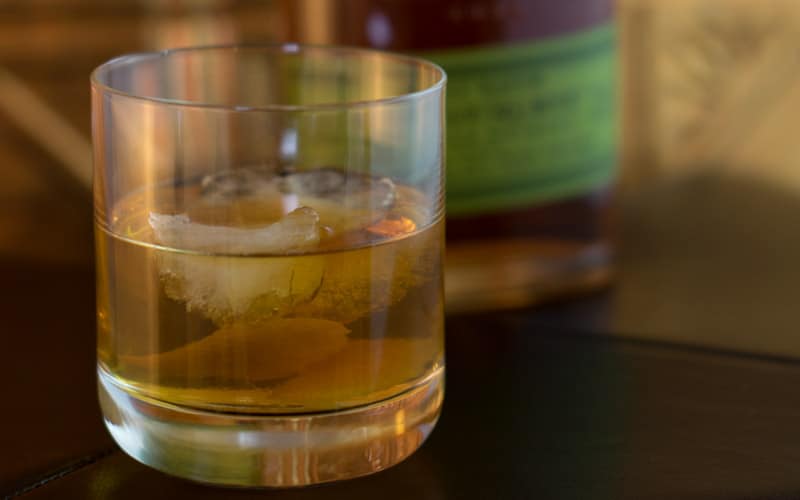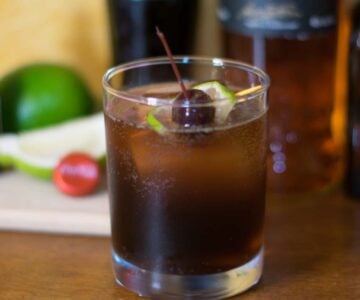Take a Drink and Travel Through Time as We Explore the Old Fashioned

Do you ever have a moment where you go from thinking you know something about something only to realize that what you don’t know could fill a small ocean? For years the Old Fashioned has been my go-to cocktail of choice, it’s one of the things I use to celebrate a good day, get through a bad day, and decide a bartender’s worth.
I thought I knew exactly what a good Old Fashioned was and what it should be, little did I know that cocktail purists would scoff at my fruit salad preferences and that a little research and a good long night of testing would lead me back in time to falling in love with an old fashioned, Old Fashioned.
The Cocktail is Born
When I started researching the drink’s history, I was surprised to find that the Old Fashioned is often linked to the origins of the term cocktail and that originally ordering an Old Fashioned referred to a style of drink that could be made with lots of different spirits. According to an article by Robert Simonson, cocktail purists started asking for old-fashioned cocktails in the late 1800s “when the whiz-bang bartenders of the post Civil War days started getting too fancy with their add-ons.”

It was only over time that an Old Fashioned became a classic whiskey drink or brandy if you live in a state that likes to wear off yellow Styrofoam wedges on your head on Sunday afternoons.
As I delved back in time, it became clear you could group the drink’s history into three periods. The first is the pre-prohibition period where the drink was essentially a sugar cube muddled with Angostura bitters topped with bourbon or rye. You can read a recipe from 1895 on Wikipedia.
At some point in the 1950s or 60s, the drink took a turn on the sweet train with the addition of muddled orange, cherries, and in some cases pineapple. To me, the mid-century Old Fashioned is epitomized by the classic Wisconsin supper club brandy Old Fashioned that you can order sweet or sour – which means your muddled fruit and sugar gets topped off with either 7-Up or Squirt. A modern reinterpretation of this drink is the Brandy Old Fashioned by Jeffrey Morgenthaler.
In the past few years, the Old Fashioned seems to have emerged from its sugar coma and is back on the path to being a mainstay of a good bar program. What’s interesting is the modern version has let go of some of its sweetness but has held on to the fruit, sometimes muddled and sometimes as a garnish. An example of the modern Old Fashioned is the International Bartender Association’s version.
To Drink is To Learn
To get at all the possible variations …sugar cube or simple syrup; fruit or no fruit; bourbon, rye, or brandy; soda sweet or sour; to muddle or not – I knew it would take a group of friends committed to drinking free booze and eating good food on a Saturday night. Normally when I send out a Thursday afternoon invitation for some mad science cooking over the weekend, I get a few yeses and lots of wish I could, but for some reason, the call of the Old Fashioned trumped everyone’s previous plans.
The plan was simple; we would take classic Old Fashioned recipes and make them in as many variations as we could to try and figure out what makes a great Old Fashioned.
To start we went way back to the first Old Fashioneds, trying the basic recipe in variations including sugar cube or simple syrup with bourbon, rye, or brandy. A couple of things stood out right away. The first was there was a real difference between the sugar cube and simple syrup. The simple syrup seemed to mellow the drink out, where the sugar cube let the liquor’s flavor through. The second thing was the difference between bourbon and rye. In this simple version, the rye brought a spicy flavor to the drink that added lots of depth, where the bourbon was more rounded with subtle brown sugar and caramel flavors.
The brandy also brought something different to the drink, which was mostly revulsion, with the exception of Stein who grew up drinking brandy Old Fashioneds in Wisconsin supper clubs. The easy winner from the early period was an Old Fashioned made with a sugar cube and rye.
From there we moved onto the mid-century version. It only took a few minutes of adding squirt and 7-Up to a couple of brandy Old Fashioneds to move on. There was an acknowledgment that the 7-Up version was better than the Squirt version, but as Meleah said, “this is just a terrible idea.”

The one brandy version that stood out was when we used Muscovado simple syrup sans sweet and sour toppings. It was so sweet that it was almost like Kool-Aid, it was the kind of drink that caused someone to say, “I would give this to a four-year-old to introduce them to brown liquor.”
To finish writing about the part of our night I’m allowed to talk about; we moved into variations on the modern Old Fashioned. Starting with what you get at most places that don’t advertise who developed their bar program – an Old Fashioned with a little simple syrup, muddled orange and cherry, Angostura bitters, and whatever whiskey you order off the middle shelf.
This is what I normally think of as an Old Fashioned and quite frankly a drink I love, what surprised me and most of the other tasters was how incredibly sweet it was compared to the classic version we started out with.
A number of tasters liked having the fruit in the drink but didn’t like how sweet it got. We all agreed there are better options for cherries then the neon colored Maraschino cherries that seem like they were created to herald in the nuclear age. What we settled on, muddled or as a garnish, are some nice Bada Bing cherries you can find in jars in most nice liquor and grocery stores.
In these modern versions, there still was a preference for sugar cube versus simple syrup. Most of our tasters were surprised by this preference, with the thinking being there shouldn’t be much difference between the two, but time and time again people preferred the cube.
There was still a preference for rye to bourbon, but it wasn’t as strong here, with the fruit masking a lot of the differences between the two. One thing that was interesting was how much the testers preferred to have the taste of the liquor come through but appreciated what the bitters, sugar cube, and lemon twist brought to the drink.
Also, because we’re thorough and want to make sure you only drink the best, we went through a series of variations using different bitters. It was fascinating to see the difference they made. The cherry vanilla bitters really brought out more of the fruit’s sweetness than the Angostura bitters did, where the Jamaica bitters are a good choice if you want a spicier drink.
In the end, we went through a half-dozen different versions to develop our interpretation of a modern Old Fashioned, finally hitting on our favorite of the night… the Umami Old Fashioned, which harkens back to the classic Old Fashioneds we liked at the beginning of the night, with a slightly modern twist.

The Umami Old Fashioned starts with a sugar cube muddled with three dashes of orange bitters. This adds the orange fruit flavor we liked but doesn’t add the additional sweetness of a muddled orange slice. Then we top it with one jigger of rye, a lemon twist, and drop in a Bing cherry for color and because it’s fun to eat the cherry at the end.
It was a lot of work and kind of a long night, especially for a few people, but in the end, we learned a lot about what makes a great Old Fashioned. Now all I need to do is figure out how to order it.
Recipes
Mark is an experienced food writer, recipe developer, and photographer who is also Umami’s publisher and CEO. A passionate cook who loves to cook for friends, he can often be found in the kitchen or by the grill testing new recipes.
More Info About Mark Hinds
Learn More
Find more recipes, tips, and ideas about these techniques, ingredients, and cuisines.








Leave a Reply